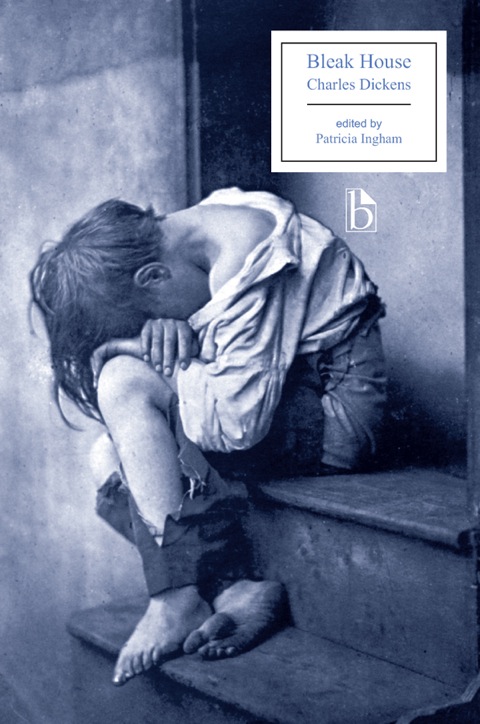Description
Efnisyfirlit
- Cover
- Title Page
- Copyright
- Dedication
- Contents
- Acknowledgements
- Introduction
- Charles Dickens: A Brief Chronology
- A Note on the Text
- Bleak House
- I.—In Chancery
- II.—In Fashion
- III.—A Progress
- IV.—Telescopic Philanthropy
- V.—A Morning Adventure
- VI.—Quite at Home
- VII.—The Ghost’s Walk
- VIII.—Covering a Multitude of Sins
- IX.—Signs and Tokens
- X.—The Law-Writer
- XI.—Our Dear Brother
- XII.—On the Watch
- XIII.—Esther’s Narrative
- XIV.—Deportment
- XV.—Bell Yard
- XVI.—Tom-All-Alone’s
- XVII.—Esther’s Narrative
- XVIII.—Lady Dedlock
- XIX.—Moving On
- XX.—A New Lodger
- XXI.—The Smallweed Family
- XXII.—Mr. Bucket
- XXIII.—Esther’s Narrative
- XXIV.—An Appeal Case
- XXV.—Mrs. Snagsby Sees It All
- XXVI.—Sharpshooters
- XXVII.—More Old Soldiers Than One
- XXVIII.—The Ironmaster
- XXIX.—The Young Man
- XXX.—Esther’s Narrative
- XXXI.—Nurse and Patient
- XXXII.—The Appointed Time
- XXXIII.—Interlopers
- XXXIV.—A Turn of the Screw
- XXXV.—Esther’s Narrative
- XXXVI.—Chesney Wold
- XXXVII.—Jarndyce and Jarndyce
- XXXVIII.—A Struggle
- XXXIX.—Attorney and Client
- XL.—National and Domestic
- XLI.—In Mr. Tulkinghorn’s Room
- XLII.—In Mr. Tulkinghorn’s Chambers
- XLIII.—Esther’s Narrative
- XLIV.—The Letter and the Answer
- XLV.—In Trust
- XLVI.—Stop Him!
- XLVII.—Jo’s Will
- XLVIII.—Closing In
- XLIX.—Dutiful Friendship
- L.—Esther’s Narrative
- LI.—Enlightened
- LII.—Obstinacy
- LIII.—The Track
- LIV.—Springing a Mine
- LV.—Flight
- LVI.—Pursuit
- LVII.—Esther’s Narrative
- LVIII.—A Wintry Day and Night
- LIX.—Esther’s Narrative
- LX.—Perspective
- LXI.—A Discovery
- LXII.—Another Discovery
- LXIII.—Steel and Iron
- LXIV.—Esther’s Narrative
- LXV.—Beginning the World
- LXVI.—Down in Lincolnshire
- LXVII.—The Close of Esther’s Narrative
- Appendix A: Dickens’s Working Notes for Bleak House
- Appendix B: The Reception of Bleak House
- 1. From The Spectator (September 1853)
- 2. From The Illustrated London News (24 September 1853)
- 3. From The Athenaeum (17 September 1853)
- 4. From The Eclectic Review (December 1853)
- 5. From Bentley’s Miscellany (8 October 1853)
- 6. From The Examiner (8 October 1853)
- 7. From The Rambler (January 1854)
- 8. From Charlotte Brontë, Letter to George Smith (11 March 1852)
- 9. From J.S. Mill, Letter to Harriet Taylor (20 March 1854)
- 10. From G.H. Lewes, Letters to Dickens (1852)
- Appendix C: The Role and Status of Women
- 1. Marriage and the Law: From William Blackstone, Commentaries on the Laws of England (1765-69)
- 2. Support for Conventional Views
- (a) From Charles Dickens, “Sucking Pigs,” Household Words (November 1851)
- (b) From “The Laws Concerning Women,” Blackwood’s Edinburgh Magazine (April 1856)
- (c) From Margaret Oliphant, “The Condition of Women,” Blackwood’s Edinburgh Magazine (February 1858)
- 3. Opposition to Conventional Views
- (a) From the Review in Foreign Quarterly Review of The Education of Mothers of Families (1842)
- (b) From Harriet Taylor, “The Enfranchisement of Women,” The Westminster and Foreign Quarterly Review (1851)
- (c) From Jessie Boucherett, Endowed Schools (1862)
- 4. Personal Testimonies from Women
- (a) From Jane Welsh Carlyle, Letter to John Forster (c. February 1844)
- (b) From Elizabeth Gaskell, Letter to Eliza Fox (12 February 1850)
- (c) From Mary Taylor, Letter to Charlotte Brontë (April 1850)
- (d) From Charlotte Brontë, Letter to Elizabeth Gaskell (20 September 1851)
- (e) From Florence Nightingale, Cassandra (1860)
- 5. Women in Contemporary Fiction
- (a) From Charlotte Brontë, Jane Eyre (1848)
- (b) From Geraldine Jewsbury, The Half Sisters (1848)
- (c) From Frances Trollope, The Young Countess or Love and Jealousy (1848)
- Appendix D: The Court of Chancery
- 1. From “Reform in the Court of Chancery,” The Times (1 April 1850)
- 2. From “Delays in Chancery,” The Times (8 August 1850)
- 3. From “Court of Chancery,” The Times (25 December 1850)
- 4. Leading Article, The Times (1 January 1851)
- 5. From Alfred Cole and W.H. Wills, “The Martyrs of Chancery,” Household Words
- (a) December 1850
- (b) February 1851
- 6. From Edward B. Sugden, “Prisoners for Contempt of the Court of Chancery,” The Times (7 January 1851)
- 7. From “A Chancery Bone of Contention,” Punch (June 1852)
- Appendix E: Attitudes to Religious and Other Proselytizing
- 1. From Charles Dickens, “Whole Hogs,” Household Words (August 1851)
- 2. From Clare Lucas Balfour, “Stopping Half Way,” The Temperance Offering (1852)
- 3. Charles Dickens, Letter to the Reverend H. Christopherson (9 July 1852)
- 4. From R.W. Vanderkiste, Notes and Narratives of a Six Years’ Mission Principally among the Dens of London (1852)
- 5. From the London Quarterly Review (January 1871)
- Appendix F: Contemporary Attitudes to Class Inequality
- 1. From Thomas Carlyle, Chartism (1839)
- 2. From Arthur Helps, The Claims of Labour (1844)
- 3. From Jessie Boucherett, “Endowed Schools” (1852)
- 4. From J.S. Mill, Principles of Political Economy (1859)
- Appendix G: Conditions of the Working Class
- 1. Living Conditions as Described in Dickens’s Household Words
- (a) From “A December Vision” (December 1850)
- (b) From “A Walk in a Workhouse” (May 1850)
- (c) From “A Nightly Scene in London” (January 1856)
- 2. Burial Grounds
- (a) From “Spa-Fields Burial Grounds,” The Times (5 March 1845)
- (b) From “Heathen and Christian Burial,” Household Words (April 1850)
- 3. Disease
- (a) From Thomas Carlyle, Past and Present (1843)
- (b) From “How Cholera is Spread,” The Lancet (13 October 1849)
- (c) [Mortality Among the Working Classes], from The Times (4 September 1851)
- 4. Epidemics and Sanitation
- (a) From Edwin Chadwick, Report on the Sanitary Conditions of the Labouring Population (1842)
- (b) [Sanitary Conditions of the city], from The Times (2 January 1851)
- (c) From a Speech by Dickens to the Metropolitan Sanitary Association (10 May 1851)
- Select Bibliography






Reviews
There are no reviews yet.